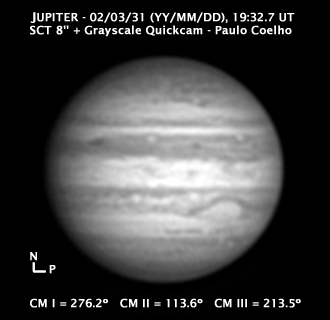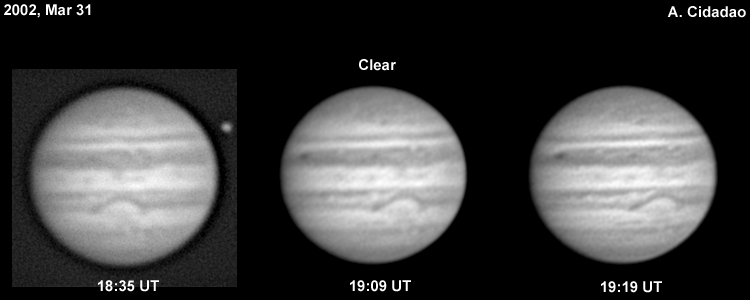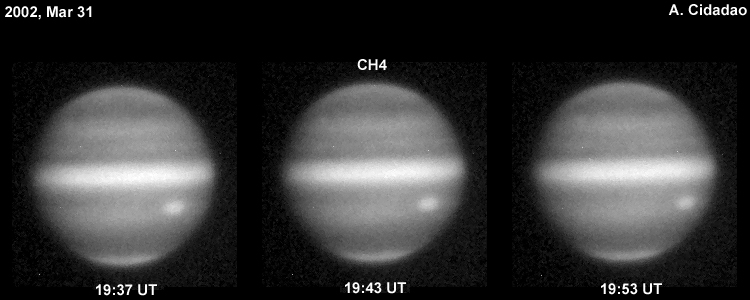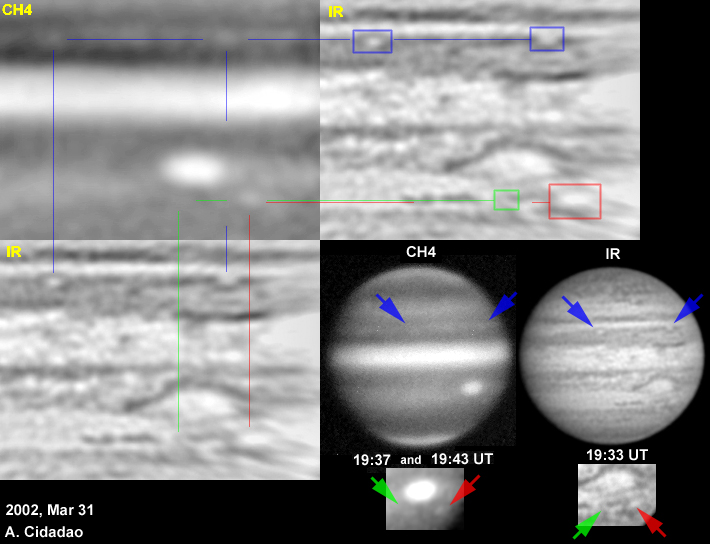木星 月惑星研究会 関西支部 (最新)
ALPO-Japan Latest
Jupiter Image 2002/03/31(UT)
Paulo Coelho,Antonio Cidadao
P.Coelho,A.Cidadao
|
Paulo Coelho ( 8'' Celestron SCT @ f/28 Toucam Pro Webcam)
|
|

Hi all,
Here are tonight's image, unfortunately didn't catch the SSTB WOS area central transit,
seeing was also not that great and start to degrade after this capture.
From the shape of the half-merged oval I'm inclined do say there is still a wobbling,
the fainter core seems at +/- 2300 (clockwise from north) from the brighter one!?
Waiting for confirmation.
Best Wishes,
Paulo
[Montijo, Portugal]
≪パウロ セホ ポルトガル≫
|
Antonio Cidadao (280mm C11+ST-237 CCD camera)
|
|



 Hi all,
Here are some methane band images obtained yesterday (Mar31), as well as a
CH4-IR mosaic made to try to evaluate feature co-distribution (IR images
were sent yesterday).
Filter data:
CH4 filter - 889nm/5nm
IR filter - 830nm and above
Cylindrical planispheres were obtained with PC-JUPOS software, exactly the
same areas of interest in CH4 and IR were cropped, and are shown (labeled
in yellow) in a way that allows easy determination of latitude and
longitude feature co-localization.
The images used to produce the planispheres are shown at the lower right
(labeled in white and with enhanced details).
Blue arrows mark NEBn white ovals, the Red arrow points to BA and the Green
arrow to the tiny oval that follows BA.
In the planispheres, similarly color-coded lat/long lines and boxes are
ascribed to those features.
Notice the good colocalization of the IR visible NEBn antyciclonic ovals
and BA with their CH4 counterparts.
With respect to the tiny oval that follows BA it appears that it is that
oval, and not the much brighter clouds that follow it (mentioned
yesterday), that coincides with the position of the very faint CH4 spot.
You may see that the original CH4 images are very grainy, and I must stress
that TWO 5min images (mid exposures at 19:37 and 19:43 UT) were used to
produce the CH4 planisphere and the CH4 globe image presented in the
mosaic. An evident planet rotation occurred between these images. For the
merely illustrative globe image, a rough average image was produced by
image shift aided by blink comparation in order to keep the GRS area at the
same location. However, planet rotation between frames is NOT an issue when
averaging planisphere projections of single images. In fact this is a very
efficient way of increasing S/N ratio when needed (and not possible by
conventional image average). Accordingly, while blink comparing and
averaging projections (obviously without any manual "tune up" shifting of
images) a very good alignment was maintained.
Here are the details of how projections were obtained (just a copy of a
message sent some time ago).
>...no attempt was made to "tune-up" the alignment of the IR and CH4
planispheres >with respect to each other after they were originated, namely
using the GRS or >anything else as a reference point. What was done, for
each IR-CH4 image pair, was >simply to enter the IR image in PC-JUPOS
software, typing the date and UT, asking >the software to find an ellipse
profile for the planetary disk and producing the first >planisphere. Then
the CH4 image was uploaded to PC-JUPOS and the respective >date and UT was
entered. The same ellipse profile originated for the IR was used >for the
CH4 image (its is virtually impossible to originate a good profile for this
type >of image due to strong limb darkening). What was done manually was to
fit the >profile into the CH4 image without knowing what kind of putative
co-localizadion >might occur. The CH4 planisphere was then originated.
Hi all,
Here are some methane band images obtained yesterday (Mar31), as well as a
CH4-IR mosaic made to try to evaluate feature co-distribution (IR images
were sent yesterday).
Filter data:
CH4 filter - 889nm/5nm
IR filter - 830nm and above
Cylindrical planispheres were obtained with PC-JUPOS software, exactly the
same areas of interest in CH4 and IR were cropped, and are shown (labeled
in yellow) in a way that allows easy determination of latitude and
longitude feature co-localization.
The images used to produce the planispheres are shown at the lower right
(labeled in white and with enhanced details).
Blue arrows mark NEBn white ovals, the Red arrow points to BA and the Green
arrow to the tiny oval that follows BA.
In the planispheres, similarly color-coded lat/long lines and boxes are
ascribed to those features.
Notice the good colocalization of the IR visible NEBn antyciclonic ovals
and BA with their CH4 counterparts.
With respect to the tiny oval that follows BA it appears that it is that
oval, and not the much brighter clouds that follow it (mentioned
yesterday), that coincides with the position of the very faint CH4 spot.
You may see that the original CH4 images are very grainy, and I must stress
that TWO 5min images (mid exposures at 19:37 and 19:43 UT) were used to
produce the CH4 planisphere and the CH4 globe image presented in the
mosaic. An evident planet rotation occurred between these images. For the
merely illustrative globe image, a rough average image was produced by
image shift aided by blink comparation in order to keep the GRS area at the
same location. However, planet rotation between frames is NOT an issue when
averaging planisphere projections of single images. In fact this is a very
efficient way of increasing S/N ratio when needed (and not possible by
conventional image average). Accordingly, while blink comparing and
averaging projections (obviously without any manual "tune up" shifting of
images) a very good alignment was maintained.
Here are the details of how projections were obtained (just a copy of a
message sent some time ago).
>...no attempt was made to "tune-up" the alignment of the IR and CH4
planispheres >with respect to each other after they were originated, namely
using the GRS or >anything else as a reference point. What was done, for
each IR-CH4 image pair, was >simply to enter the IR image in PC-JUPOS
software, typing the date and UT, asking >the software to find an ellipse
profile for the planetary disk and producing the first >planisphere. Then
the CH4 image was uploaded to PC-JUPOS and the respective >date and UT was
entered. The same ellipse profile originated for the IR was used >for the
CH4 image (its is virtually impossible to originate a good profile for this
type >of image due to strong limb darkening). What was done manually was to
fit the >profile into the CH4 image without knowing what kind of putative
co-localizadion >might occur. The CH4 planisphere was then originated.

 ≪アントニオ シダダオ ポルトガル≫
≪アントニオ シダダオ ポルトガル≫
[Antonio Cidadao Oeiras - Portugal ]
|
 ALPO-Japan Latest
ALPO-Japan Latest  Jupiter Section
Jupiter Section


 Hi all,
Here are some methane band images obtained yesterday (Mar31), as well as a
CH4-IR mosaic made to try to evaluate feature co-distribution (IR images
were sent yesterday).
Filter data:
CH4 filter - 889nm/5nm
IR filter - 830nm and above
Cylindrical planispheres were obtained with PC-JUPOS software, exactly the
same areas of interest in CH4 and IR were cropped, and are shown (labeled
in yellow) in a way that allows easy determination of latitude and
longitude feature co-localization.
The images used to produce the planispheres are shown at the lower right
(labeled in white and with enhanced details).
Blue arrows mark NEBn white ovals, the Red arrow points to BA and the Green
arrow to the tiny oval that follows BA.
In the planispheres, similarly color-coded lat/long lines and boxes are
ascribed to those features.
Notice the good colocalization of the IR visible NEBn antyciclonic ovals
and BA with their CH4 counterparts.
With respect to the tiny oval that follows BA it appears that it is that
oval, and not the much brighter clouds that follow it (mentioned
yesterday), that coincides with the position of the very faint CH4 spot.
You may see that the original CH4 images are very grainy, and I must stress
that TWO 5min images (mid exposures at 19:37 and 19:43 UT) were used to
produce the CH4 planisphere and the CH4 globe image presented in the
mosaic. An evident planet rotation occurred between these images. For the
merely illustrative globe image, a rough average image was produced by
image shift aided by blink comparation in order to keep the GRS area at the
same location. However, planet rotation between frames is NOT an issue when
averaging planisphere projections of single images. In fact this is a very
efficient way of increasing S/N ratio when needed (and not possible by
conventional image average). Accordingly, while blink comparing and
averaging projections (obviously without any manual "tune up" shifting of
images) a very good alignment was maintained.
Here are the details of how projections were obtained (just a copy of a
message sent some time ago).
>...no attempt was made to "tune-up" the alignment of the IR and CH4
planispheres >with respect to each other after they were originated, namely
using the GRS or >anything else as a reference point. What was done, for
each IR-CH4 image pair, was >simply to enter the IR image in PC-JUPOS
software, typing the date and UT, asking >the software to find an ellipse
profile for the planetary disk and producing the first >planisphere. Then
the CH4 image was uploaded to PC-JUPOS and the respective >date and UT was
entered. The same ellipse profile originated for the IR was used >for the
CH4 image (its is virtually impossible to originate a good profile for this
type >of image due to strong limb darkening). What was done manually was to
fit the >profile into the CH4 image without knowing what kind of putative
co-localizadion >might occur. The CH4 planisphere was then originated.
Hi all,
Here are some methane band images obtained yesterday (Mar31), as well as a
CH4-IR mosaic made to try to evaluate feature co-distribution (IR images
were sent yesterday).
Filter data:
CH4 filter - 889nm/5nm
IR filter - 830nm and above
Cylindrical planispheres were obtained with PC-JUPOS software, exactly the
same areas of interest in CH4 and IR were cropped, and are shown (labeled
in yellow) in a way that allows easy determination of latitude and
longitude feature co-localization.
The images used to produce the planispheres are shown at the lower right
(labeled in white and with enhanced details).
Blue arrows mark NEBn white ovals, the Red arrow points to BA and the Green
arrow to the tiny oval that follows BA.
In the planispheres, similarly color-coded lat/long lines and boxes are
ascribed to those features.
Notice the good colocalization of the IR visible NEBn antyciclonic ovals
and BA with their CH4 counterparts.
With respect to the tiny oval that follows BA it appears that it is that
oval, and not the much brighter clouds that follow it (mentioned
yesterday), that coincides with the position of the very faint CH4 spot.
You may see that the original CH4 images are very grainy, and I must stress
that TWO 5min images (mid exposures at 19:37 and 19:43 UT) were used to
produce the CH4 planisphere and the CH4 globe image presented in the
mosaic. An evident planet rotation occurred between these images. For the
merely illustrative globe image, a rough average image was produced by
image shift aided by blink comparation in order to keep the GRS area at the
same location. However, planet rotation between frames is NOT an issue when
averaging planisphere projections of single images. In fact this is a very
efficient way of increasing S/N ratio when needed (and not possible by
conventional image average). Accordingly, while blink comparing and
averaging projections (obviously without any manual "tune up" shifting of
images) a very good alignment was maintained.
Here are the details of how projections were obtained (just a copy of a
message sent some time ago).
>...no attempt was made to "tune-up" the alignment of the IR and CH4
planispheres >with respect to each other after they were originated, namely
using the GRS or >anything else as a reference point. What was done, for
each IR-CH4 image pair, was >simply to enter the IR image in PC-JUPOS
software, typing the date and UT, asking >the software to find an ellipse
profile for the planetary disk and producing the first >planisphere. Then
the CH4 image was uploaded to PC-JUPOS and the respective >date and UT was
entered. The same ellipse profile originated for the IR was used >for the
CH4 image (its is virtually impossible to originate a good profile for this
type >of image due to strong limb darkening). What was done manually was to
fit the >profile into the CH4 image without knowing what kind of putative
co-localizadion >might occur. The CH4 planisphere was then originated.

 ≪アントニオ シダダオ ポルトガル≫
≪アントニオ シダダオ ポルトガル≫
 ALPO-Japan Latest
ALPO-Japan Latest  Jupiter Section
Jupiter Section

